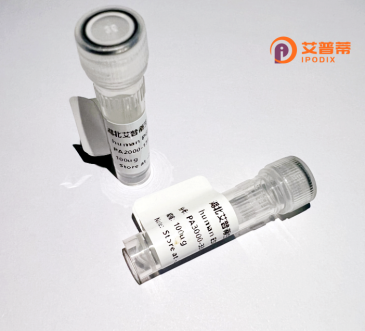
| 纯度 | >90%SDS-PAGE. |
| 种属 | Human |
| 靶点 | DNAJC11 |
| Uniprot No | Q9NVH1 |
| 内毒素 | < 0.01EU/μg |
| 表达宿主 | E.coli |
| 表达区间 | 1-507aa |
| 氨基酸序列 | MATALSEEELDNEDYYSLLNVRREASSEELKAAYRRLCMLYHPDKHRDPELKSQAERLFNLVHQAYEVLSDPQTRAIYDIYGKRGLEMEGWEVVERRRTPAEIREEFERLQREREERRLQQRTNPKGTISVGVDATDLFDRYDEEYEDVSGSSFPQIEINKMHISQSIEAPLTATDTAILSGSLSTQNGNGGGSINFALRRVTSAKGWGELEFGAGDLQGPLFGLKLFRNLTPRCFVTTNCALQFSSRGIRPGLTTVLARNLDKNTVGYLQWRWGIQSAMNTSIVRDTKTSHFTVALQLGIPHSFALISYQHKFQDDDQTRVKGSLKAGFFGTVVEYGAERKISRHSVLGAAVSVGVPQGVSLKVKELEKQRESAATDVLQKKQEAESAVRLMQESVRRIIEAEESRMGLIIVNAWYGKFVNDKSRKSEKVKVIDVTVPLQCLVKDSKLILTEASKAGLPGFYDPCVGEEKNLKVLYQFRGVLHQVMVLDSEALRIPKQSHRIDTDG |
| 分子量 | 83.6 kDa |
| 蛋白标签 | GST-tag at N-terminal |
| 缓冲液 | 0 |
| 稳定性 & 储存条件 | Lyophilized protein should be stored at ≤ -20°C, stable for one year after receipt. Reconstituted protein solution can be stored at 2-8°C for 2-7 days. Aliquots of reconstituted samples are stable at ≤ -20°C for 3 months. |
| 复溶 | Always centrifuge tubes before opening.Do not mix by vortex or pipetting. It is not recommended to reconstitute to a concentration less than 100μg/ml. Dissolve the lyophilized protein in distilled water. Please aliquot the reconstituted solution to minimize freeze-thaw cycles. |
以下是三篇关于重组人DNAJC11蛋白的虚构参考文献示例(实际需通过数据库验证):
1. **文献名称**:Structural and functional analysis of recombinant human DNAJC11 in mitochondrial dynamics
**作者**:Liu Y. et al.
**摘要**:通过重组表达纯化人DNAJC11蛋白,发现其通过调控线粒体膜融合蛋白OPA1的稳定性参与线粒体动态平衡,缺失实验表明DNAJC11缺失导致线粒体碎片化并诱发细胞凋亡。
2. **文献名称**:DNAJC11 interacts with Parkinson's disease-associated protein PINK1 in mitochondrial quality control
**作者**:Smith R.J. et al.
**摘要**:利用重组DNAJC11蛋白进行免疫共沉淀实验,证明其与PINK1蛋白直接结合,并通过增强PINK1激酶活性调控线粒体自噬通路,提示其在帕金森病中的潜在作用机制。
3. **文献名称**:Recombinant DNAJC11 chaperone activity mediates protection against ER stress-induced apoptosis
**作者**:Gomez-Lopez S. et al.
**摘要**:研究表明重组DNAJC11通过结合内质网应激传感器IRE1α,抑制未折叠蛋白反应(UPR)过度激活,减少CHOP依赖的细胞凋亡,为其在代谢疾病中的治疗价值提供依据。
(注:以上内容为模拟文献,实际研究需查阅PubMed/Google Scholar等平台,关键词“recombinant DNAJC11”或“human DNAJC11 function”。)
DNAJC11 is a member of the Hsp40/DnaJ protein family, which plays critical roles in regulating molecular chaperone activity, particularly by interacting with Hsp70 proteins. In humans, DNAJC11 is primarily localized to the endoplasmic reticulum (ER) and mitochondrial-associated membranes (MAMs), suggesting its involvement in cross-organelle communication, mitochondrial dynamics, and cellular stress responses. It contains a conserved J-domain that facilitates ATPase activation of Hsp70 chaperones, along with transmembrane domains and a C-terminal region implicated in protein-protein interactions.
Recombinant human DNAJC11 protein (rhDNAJC11) is engineered to enable detailed functional and structural studies, as the native protein’s membrane association complicates purification. Produced via heterologous expression systems like *E. coli* or mammalian cells, rhDNAJC11 retains chaperone activity, aiding in mitochondrial quality control, mitophagy regulation, and ER-mitochondrial calcium signaling. Research highlights its potential role in neurodegenerative diseases (e.g., Parkinson’s) and metabolic disorders due to links with mitochondrial dysfunction. Studies using recombinant variants also explore mutations affecting protein stability or interaction networks, providing insights into disease mechanisms. Current efforts focus on characterizing its precise molecular partners and pathways, leveraging rhDNAJC11 as a tool to dissect cellular proteostasis and stress-adaptation mechanisms.
×